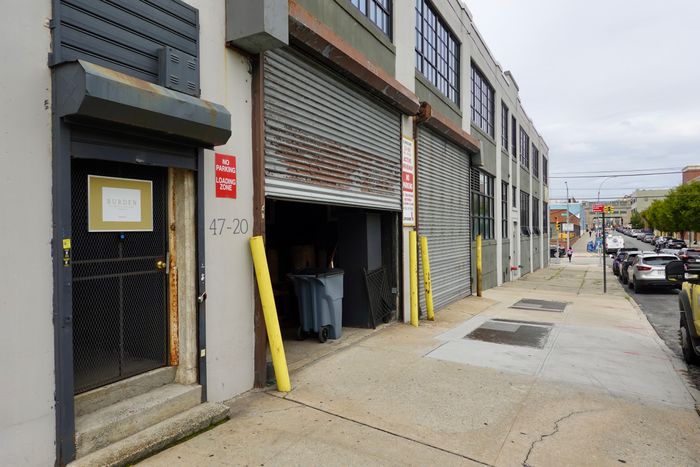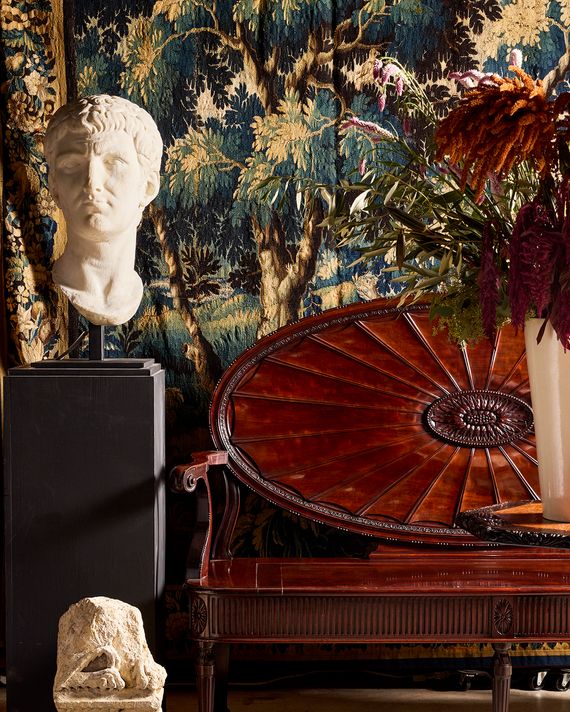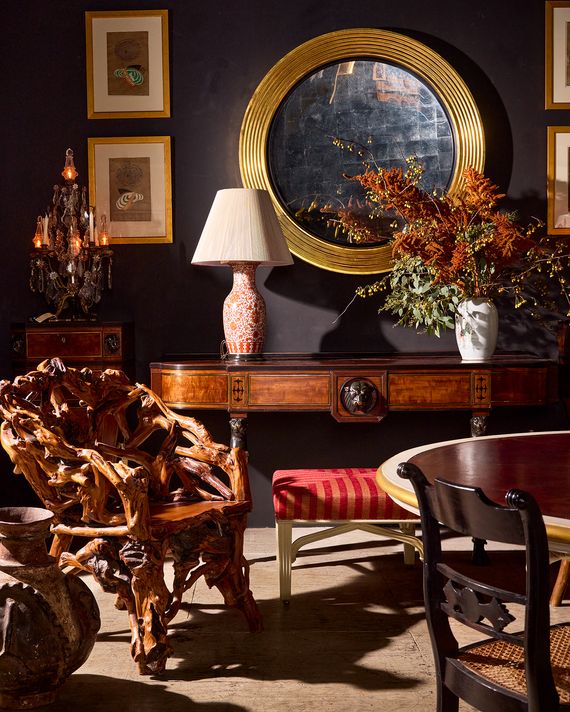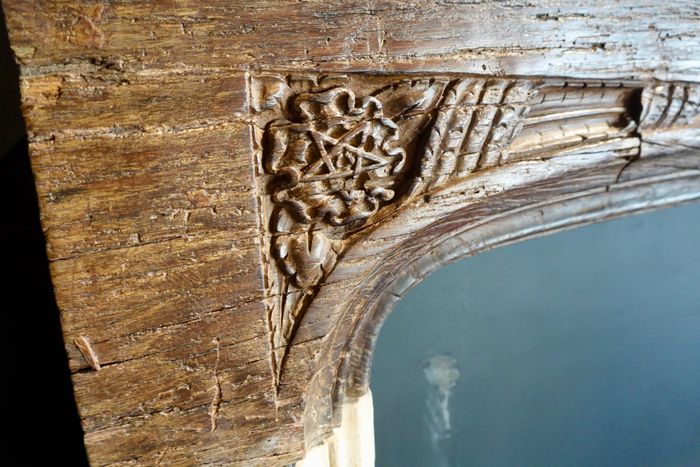Jonathan Burden in his studio with a Languedoc marble table from 18th-century France made under Louis XVI. It weighs around one ton and wound up in a Fifth Avenue apartment where an owner designed a parquet floor around it.
Photo: Dana Gallagher
It’s not easy to sell off a nine-foot-tall, seven-foot-wide 18th-century Dutch cabinet to New Yorkers stingy about square footage, but the antiques dealer Jonathan Burden has a pitch. Weaving between $10,000 chairs, he says the piece comes apart into ten sections — easy for squeezing into an elevator. As for its size, “You’ve just got to have the nerve to do it.” It’s fairly convincing, especially when delivered in Burden’s musical British accent. Even so, the cabinet has been gathering dust for about ten years — leaving Burden to drag it from his last shop in Tribeca to a warehouse in Long Island City where it now sits alongside British daybeds, Scottish sideboards, and Dutch rondelles. “You get to a point where you just have to say, ‘Look. We have to put a sale together,’” he tells me. “I have to clear house.”
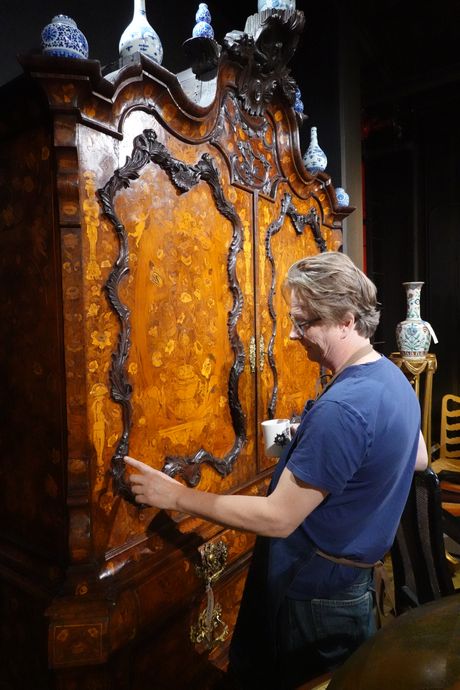

From left: Burden shows how scrollwork on the 18th-century cabinet reveals the influence of trade with China. Photo: Adriane QuinlanPointing to daybeds owned by the Duchess of Windsor in a storage area. Photo: Adriane Quinlan
From top: Burden shows how scrollwork on the 18th-century cabinet reveals the influence of trade with China. Photo: Adriane QuinlanPointing to daybeds…
From top: Burden shows how scrollwork on the 18th-century cabinet reveals the influence of trade with China. Photo: Adriane QuinlanPointing to daybeds owned by the Duchess of Windsor in a storage area. Photo: Adriane Quinlan
Burden is now prepping for a kind of fancy fire sale, organized with Christie’s. It’s pushing the auction house into a new format: Instead of showing the pieces at Christie’s headquarters at Rockefeller Plaza, the furniture will stay in situ in the warehouse, giving bidders two weeks to test the comfort of Chinese root chairs or stroll into the usually secret workroom where Burden restores pieces, whose walls display a lifetime collection of antique wood scraps and tools that resemble torture devices. It’s a space that feels “Instagrammable to the nth degree,” says Christie’s vice-president of communications, Edward Lewine, who is walking me through the warehouse along with Burden and Elizabeth Seigel, a vice-president of private and iconic collections at Christie’s, who has another lure for the shoppers coming through: One-third of the items on auction will have no reserve price, so a charming pair of French chairs with cutouts of spades and hearts may sell for the opening bid of $100. “The prices realistically are cheaper than going to Restoration Hardware,” Seigel says.


Tools and scraps of rare wood in the workshop. Adriane Quinlan.
Tools and scraps of rare wood in the workshop. Adriane Quinlan.
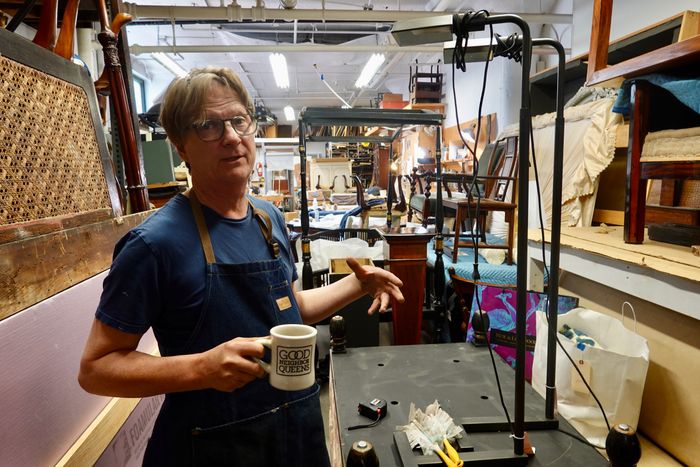
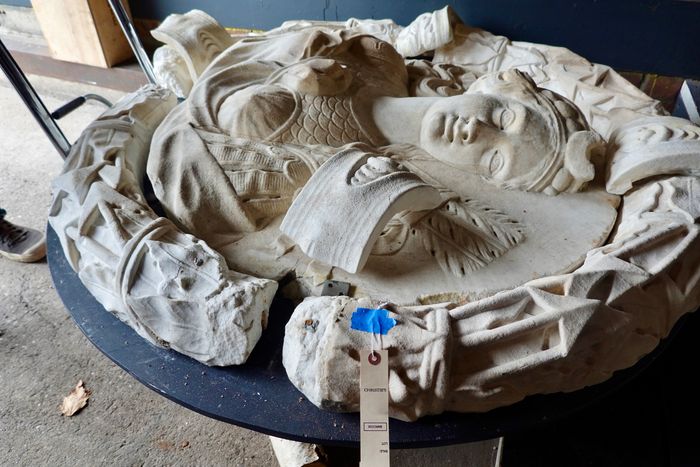
From left: Photo: Adriane QuinlanPhoto: Adriane Quinlan
From top: Photo: Adriane QuinlanPhoto: Adriane Quinlan
This would have been unimaginable to a young Burden, who came to New York at the peak of the market for European antiques. Burden landed here in the 1980s, when Park Avenue was clamoring after the stuff. It was a ‘Get on the next plane’ kind of thing,” he tells me. Educated in restoration in the United Kingdom, he was recruited by Sotheby’s but left when he saw how much more he could make on his own. Sales he now refers to as “coups” include a set of 12 chairs he recognized in a dusty shop on Atlantic Avenue, which he snagged for $1,700 and flipped for $38,000, or a card table that went for $800 at auction but cleaned up nicely to resell for $21,000. After starting out in a cheap space in South Williamsburg, where his clients were the old-world dealers of Madison Avenue, he soon had enough to start his own shop in the West Village with a niche aesthetic: the rustic, warm wood furniture of the British countryside. “I was always trying to find a piece that housekeepers had lovingly dusted and waxed over a few hundred years.”
The sale will continue even into the room that Burden currently uses as a staff lounge and library, where research volumes sometimes help identify provenance or suggest proper repairs.
Photo: Adriane Quinlan
But tastes changed. Buyers were no longer filling charming West Village apartments with charming furniture. They were living in high-ceilinged industrial lofts and looking for big statement pieces that wouldn’t drown in their huge, bright spaces. In 1995, Burden followed them to a former Tribeca factory that faced the odd triangle of Duane Park, where dealers would pull up with vans on weekends, creating a miniature antique district that peaked around 2000. “Harvey Keitel and The Sopranos guys were all living in Tribeca and would come in and make rude comments about ostentatious furniture, then buy it,” Burden remembers. He mixed funky modern pieces, like a Zig Zag chair by Gerrit Rietveld, with a Jacobean table, showing clients how they could live with more oomph. “It worked great.” He was living above the shop in a white-box industrial loft himself, where he mixed American Psycho sleekness (a low, marshmallowy white Harvey Prober sectional sofa) with antiques that didn’t fly off the shelves, like a mirrored bureau and a Parisian steel desk that he put in his daughter’s room. (A turn toward nationalism and early Americana had pushed them out of favor, but he said he ended up selling the desk for half a million dollars after it was appraised as an original Jean-Michel Frank.)
The arrival of antique-resale sites shifted how he made picks. He couldn’t lower prices to match dealers who didn’t pay rent in Manhattan, so he pivoted to pieces that had no competition: a unique 2,500-piece Bernini chandelier so big that it had to be set up with scaffolding. It sold “somehow,” he said. But it didn’t justify the rent when even pro decorators stopped coming by. “They made more money sitting at their desks than going around in a taxi looking at things,” Burden says. “I felt very sort of let down and lost.” A slew of museums and auction houses had warehouses in Long Island City, so in 2016 he followed them out there and tried to pivot to online sales, cutting down his staff from seven at its peak to what it is now: a full-time restorer and a part-time assistant.
The shop Burden runs now is just a block from the 7 train but not designed to pull in foot traffic. It is typically appointment only.
Photo: Adriane Quinlan
But Christie’s and Burden are hopeful again. Sure, no one is buying up matching sets of Regency furniture to create “period rooms,” per Seigel, the Christie’s executive overseeing the sale. “But maybe you do want this one piece of brown furniture that can help anchor the rest.” She has watched a new generation of buyers who want “anchor” pieces to come with a backstory that can roll off the tongue during a dinner party. “We love telling stories, and Jonny is such a wonderful storyteller,” says Seigel. She plans to bring at least four tour groups, including a group of young decorators, through the workshop to meet and learn from Burden. They may come to love these pieces the way Burden clearly does, always dreaming up new ways to enjoy them. Standing in front of a pair of spindly Indian daybeds, Burden lifts one by the corner, demonstrating how light they are. “You could put the canopy on them and lounge there and eat grapes.”
The auction runs from September 24 to October 8. Burden’s is open for viewings from 10 a.m. to 4 p.m. through October 7 at 47-20 33rd Street, Long Island City. To schedule a viewing outside of the regular hours, email BurdenInquiries@christies.com
A mahogany hall bench from Britain, a bust of Emperor Galba, and an Aubusson Verdure tapestry.
Photo: Dana Gallagher
A Chinese root chair (left).
Photo: Dana Gallagher
The Tudor rose in a mantelpiece from the 1500s.
Photo: Adriane Quinlan



